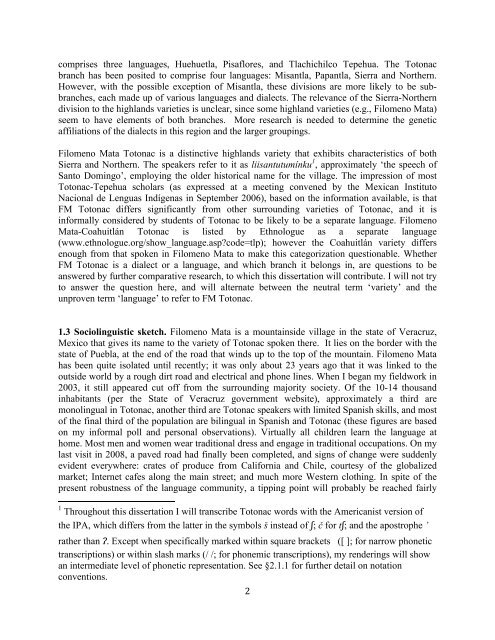The phonology and morphology of Filomeno Mata Totonac
The phonology and morphology of Filomeno Mata Totonac
The phonology and morphology of Filomeno Mata Totonac
You also want an ePaper? Increase the reach of your titles
YUMPU automatically turns print PDFs into web optimized ePapers that Google loves.
comprises three languages, Huehuetla, Pisaflores, <strong>and</strong> Tlachichilco Tepehua. <strong>The</strong> <strong>Totonac</strong><br />
branch has been posited to comprise four languages: Misantla, Papantla, Sierra <strong>and</strong> Northern.<br />
However, with the possible exception <strong>of</strong> Misantla, these divisions are more likely to be subbranches,<br />
each made up <strong>of</strong> various languages <strong>and</strong> dialects. <strong>The</strong> relevance <strong>of</strong> the Sierra-Northern<br />
division to the highl<strong>and</strong>s varieties is unclear, since some highl<strong>and</strong> varieties (e.g., <strong>Filomeno</strong> <strong>Mata</strong>)<br />
seem to have elements <strong>of</strong> both branches. More research is needed to determine the genetic<br />
affiliations <strong>of</strong> the dialects in this region <strong>and</strong> the larger groupings.<br />
<strong>Filomeno</strong> <strong>Mata</strong> <strong>Totonac</strong> is a distinctive highl<strong>and</strong>s variety that exhibits characteristics <strong>of</strong> both<br />
Sierra <strong>and</strong> Northern. <strong>The</strong> speakers refer to it as liisantutumínku 1 , approximately ‘the speech <strong>of</strong><br />
Santo Domingo’, employing the older historical name for the village. <strong>The</strong> impression <strong>of</strong> most<br />
<strong>Totonac</strong>-Tepehua scholars (as expressed at a meeting convened by the Mexican Instituto<br />
Nacional de Lenguas Indígenas in September 2006), based on the information available, is that<br />
FM <strong>Totonac</strong> differs significantly from other surrounding varieties <strong>of</strong> <strong>Totonac</strong>, <strong>and</strong> it is<br />
informally considered by students <strong>of</strong> <strong>Totonac</strong> to be likely to be a separate language. <strong>Filomeno</strong><br />
<strong>Mata</strong>-Coahuitlán <strong>Totonac</strong> is listed by Ethnologue as a separate language<br />
(www.ethnologue.org/show_language.asp?code=tlp); however the Coahuitlán variety differs<br />
enough from that spoken in <strong>Filomeno</strong> <strong>Mata</strong> to make this categorization questionable. Whether<br />
FM <strong>Totonac</strong> is a dialect or a language, <strong>and</strong> which branch it belongs in, are questions to be<br />
answered by further comparative research, to which this dissertation will contribute. I will not try<br />
to answer the question here, <strong>and</strong> will alternate between the neutral term ‘variety’ <strong>and</strong> the<br />
unproven term ‘language’ to refer to FM <strong>Totonac</strong>.<br />
1.3 Sociolinguistic sketch. <strong>Filomeno</strong> <strong>Mata</strong> is a mountainside village in the state <strong>of</strong> Veracruz,<br />
Mexico that gives its name to the variety <strong>of</strong> <strong>Totonac</strong> spoken there. It lies on the border with the<br />
state <strong>of</strong> Puebla, at the end <strong>of</strong> the road that winds up to the top <strong>of</strong> the mountain. <strong>Filomeno</strong> <strong>Mata</strong><br />
has been quite isolated until recently; it was only about 23 years ago that it was linked to the<br />
outside world by a rough dirt road <strong>and</strong> electrical <strong>and</strong> phone lines. When I began my fieldwork in<br />
2003, it still appeared cut <strong>of</strong>f from the surrounding majority society. Of the 10-14 thous<strong>and</strong><br />
inhabitants (per the State <strong>of</strong> Veracruz government website), approximately a third are<br />
monolingual in <strong>Totonac</strong>, another third are <strong>Totonac</strong> speakers with limited Spanish skills, <strong>and</strong> most<br />
<strong>of</strong> the final third <strong>of</strong> the population are bilingual in Spanish <strong>and</strong> <strong>Totonac</strong> (these figures are based<br />
on my informal poll <strong>and</strong> personal observations). Virtually all children learn the language at<br />
home. Most men <strong>and</strong> women wear traditional dress <strong>and</strong> engage in traditional occupations. On my<br />
last visit in 2008, a paved road had finally been completed, <strong>and</strong> signs <strong>of</strong> change were suddenly<br />
evident everywhere: crates <strong>of</strong> produce from California <strong>and</strong> Chile, courtesy <strong>of</strong> the globalized<br />
market; Internet cafes along the main street; <strong>and</strong> much more Western clothing. In spite <strong>of</strong> the<br />
present robustness <strong>of</strong> the language community, a tipping point will probably be reached fairly<br />
1 Throughout this dissertation I will transcribe <strong>Totonac</strong> words with the Americanist version <strong>of</strong><br />
the IPA, which differs from the latter in the symbols # instead <strong>of</strong> #; $ for t#; <strong>and</strong> the apostrophe ’<br />
rather than $. Except when specifically marked within square brackets ([ ]; for narrow phonetic<br />
transcriptions) or within slash marks (/ /; for phonemic transcriptions), my renderings will show<br />
an intermediate level <strong>of</strong> phonetic representation. See §2.1.1 for further detail on notation<br />
conventions.<br />
! #!

















